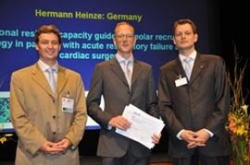Prize for advances in respiratory monitoring
During the Congress of the European Society of Intensive Care Medicine (ESICM) the research work of Hermann Heinze from the Clinic for Anesthesiology and Intensive Care Medicine of the Schleswig-Holstein University Hospital was honoured with the first "Bernhard Dräger Award for Advanced Treatment of Acute Respiratory Failure".

Marco Ranieri, President of the ESICM, and Daniel de Backer, Chairman of the ESICM research committee, awarded the prize together with Frank Ralfs, the leading product manager for respirators at Dräger. This annual prize was created to support research projects relating to intensive care medicine that are dedicated to the progressive treatment of acute respiratory insufficiency. This year the focus was on improving respiration therapy using non-invasive monitoring. Heinze was awarded the prize to investigate the ’Functional residual capacity guided alveolar recruitment strategy in patients with acute respiratory failure after cardiac surgery1’ over the next 12 months.
Heinze will measure lung volumes in order to study the extent to which managing so-called ‘recruitment manoeuvres2’ can contribute towards making ventilation more effective and cause fewer side effects. Measuring lung volume at the bedside, the so-called functional residual capacity (FRC), has only recently become possible without needing considerable effort. By monitoring the FRC using electric impedance tomography (EIT) for the first time, it should be possible to carry out recruitment manoeuvres in a more targeted manner since this technique provides a continuous, radiation-free and spatial depiction of lung ventilation.
In addition, by analyzing inflammation mediators in blood, the research project aims to prove that applied respiratory manoeuvres provide a less harmful therapy. This is important because inflammation in the lung, and other parts of the body, is a widespread side-effect of ventilation and may be one of the main causes of high mortality in patients with acute respiratory failure.
The 36-year-old prize-winner Hermann Heinze works in the Anesthesiology Clinic at Lübeck University. He will conduct the research project over the coming year jointly with associate professor Wolfgang Eichler. According to Daniel de Backer, chairman of the research committee of the ESICM, “The scientific committee of the ESICM chose this project as it investigates promising, non-invasive approaches of respiratory monitoring, which have the potential to significantly contribute to lung protective ventilation”.
Origin of the prize
The prize is named after Dr Ing. h.c. Bernhard Dräger (1870 – 1928), the son of company founder Heinrich Dräger. In just 28 years, he and his father were awarded 261 German, 443 foreign and 912 utility patents. Bernhard Dräger’s credo was ‘invention is an act of imagination, the creation of something new’. The inventor was also dedicated to science. In 1893 he attended the Technical University in Berlin as a guest student for two semesters to study kinematics, machine elements, tools, and philosophy. This prize aims to help today’s inventors to dedicate themselves to the advancement of clinical science.
About Dräger
Founded in 1889, Drägerwerk AG & Co. KGaA is an international leader in the fields of medical and safety technology. Dräger products protect, support and save human life. In 2007, the Group achieved sales of €1,819.5 million worldwide and an EBIT of €151.9 million. Today, Dräger employs around 10,000 people in more than 70 subsidiaries worldwide and has representation in around 190 countries. The medical division offers products, services and integrated system solutions which accompany the patient throughout the care process – Emergency Care, Perioperative Care, Critical Care or Perinatal care and Home Mechanical Ventilation.
1 The control of the alveolar recruitment strategy based on the functional residual capacity of heart surgery patients with lung failure
2 This is a manoeuver to reopen collapsed lung tissue.
29.09.2008









